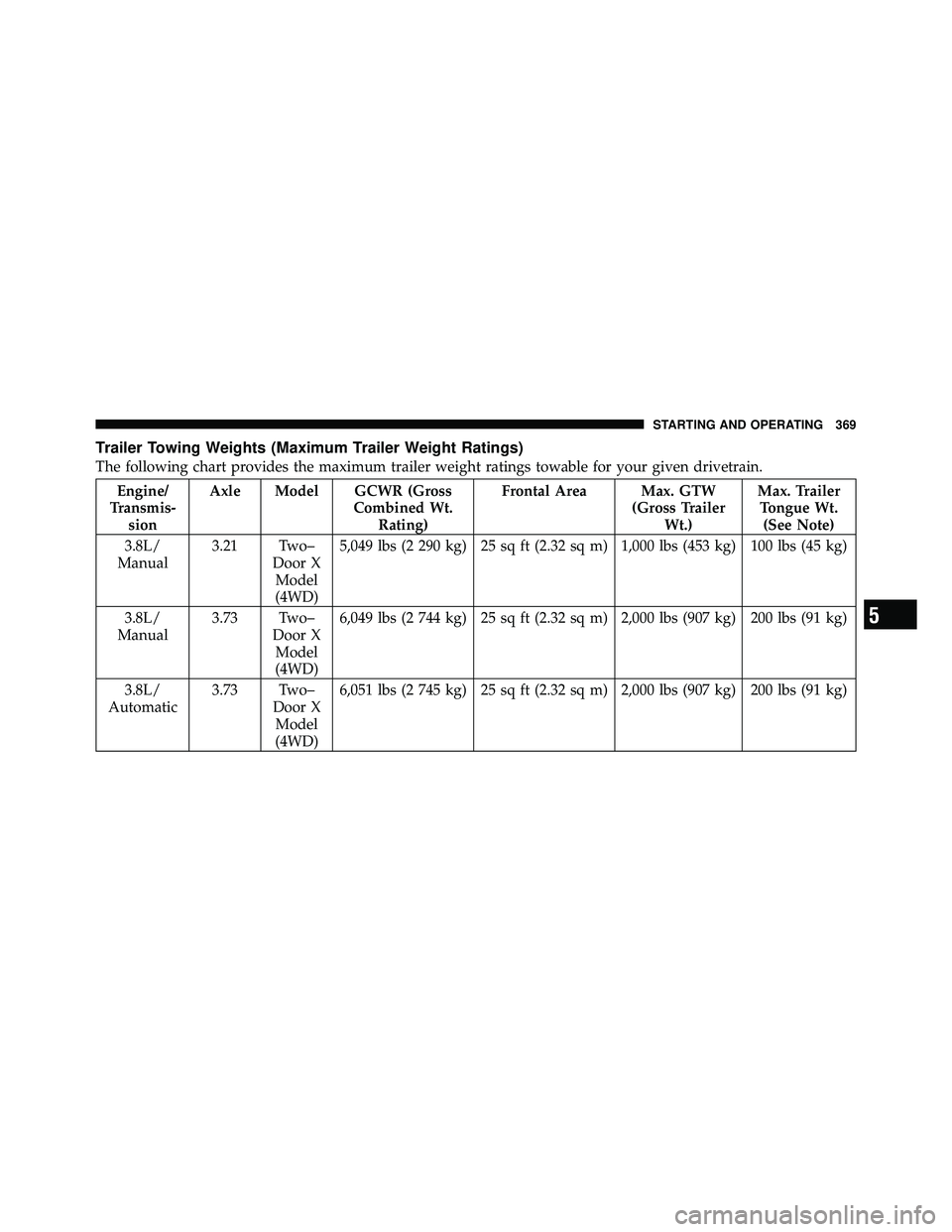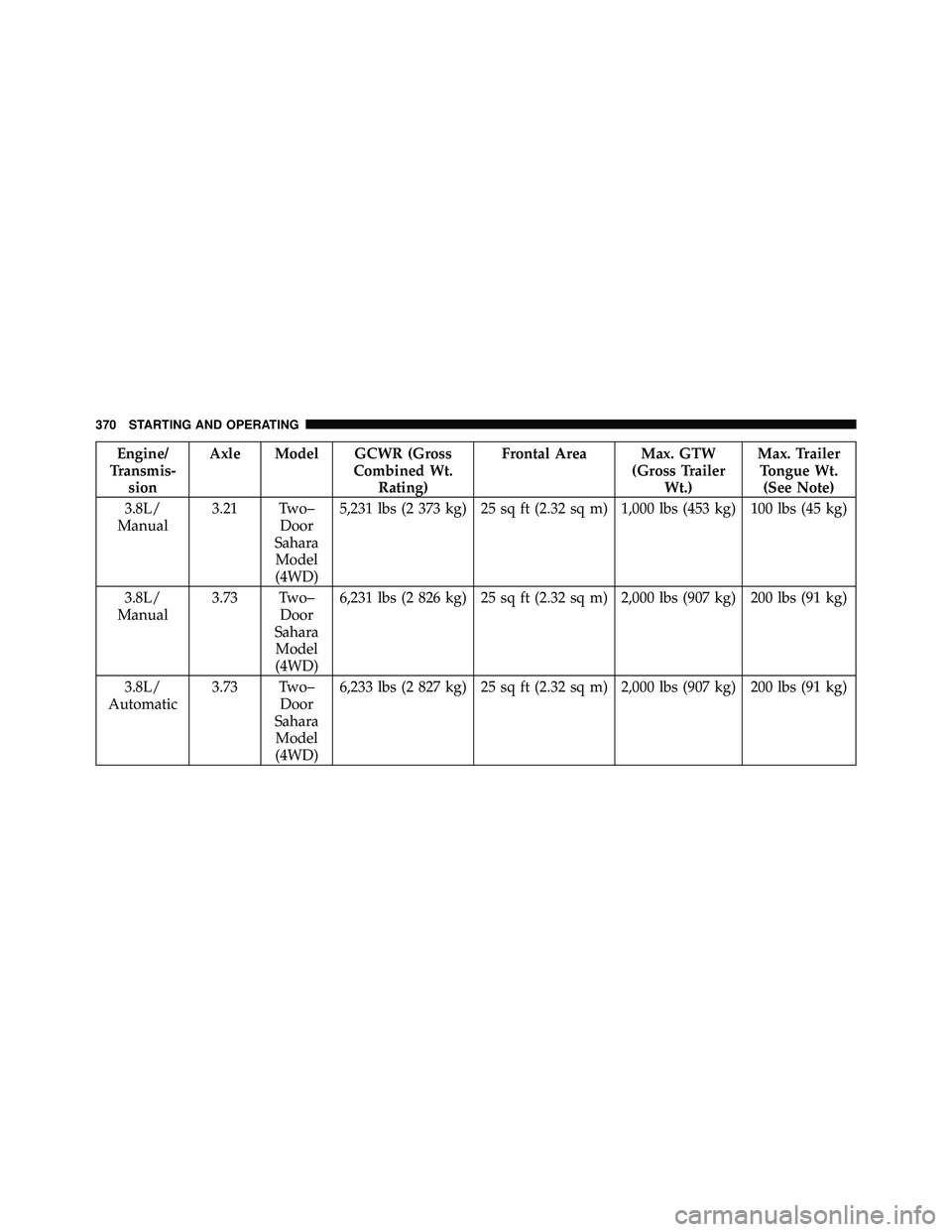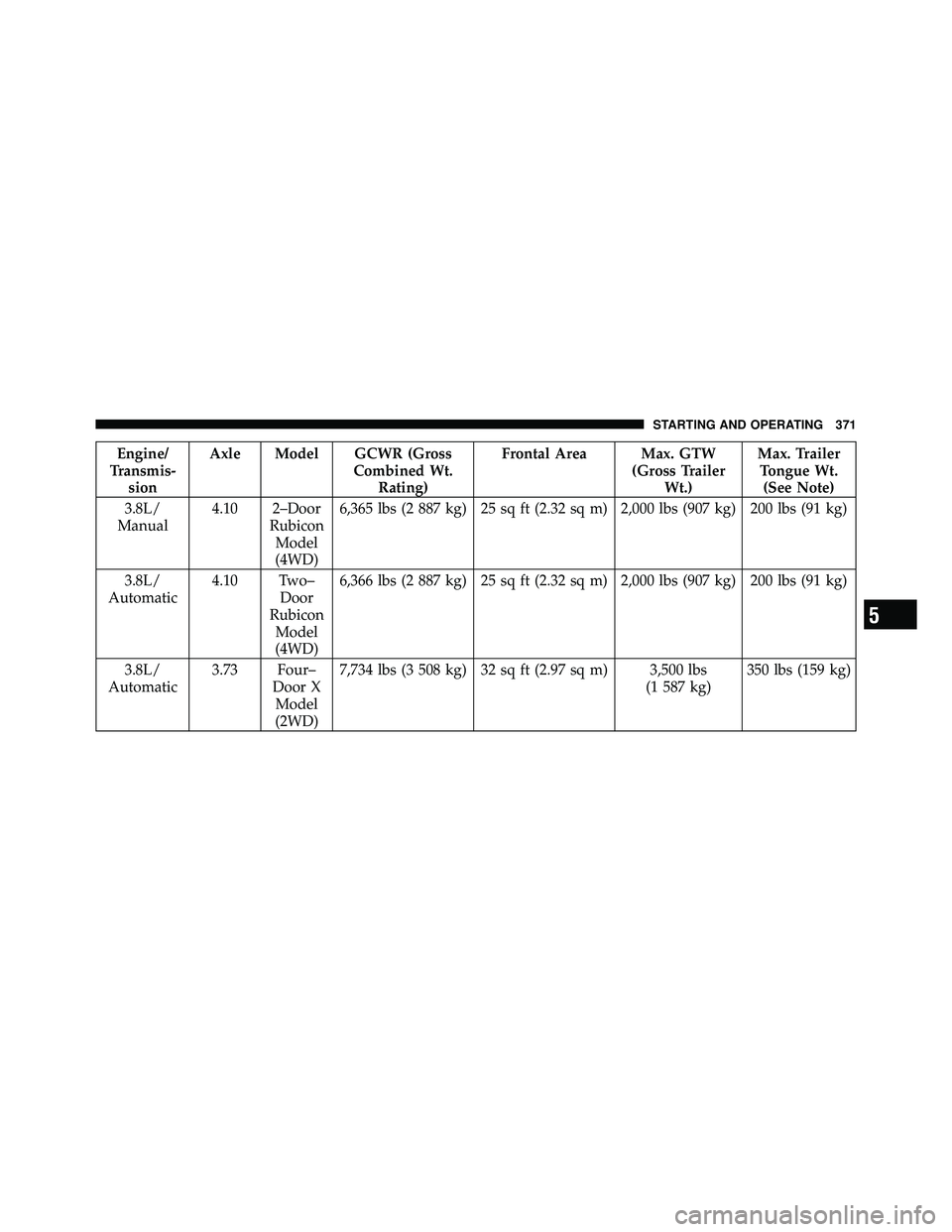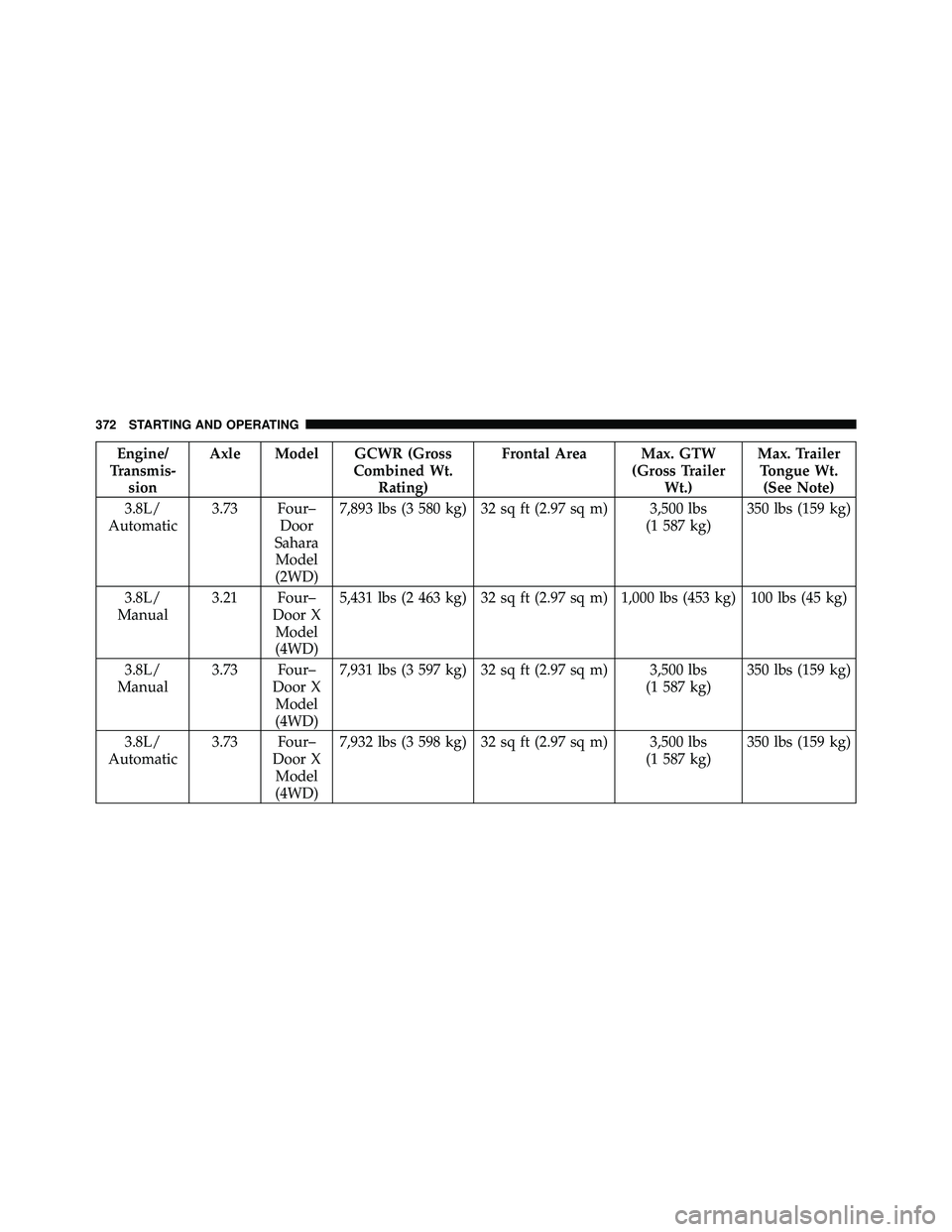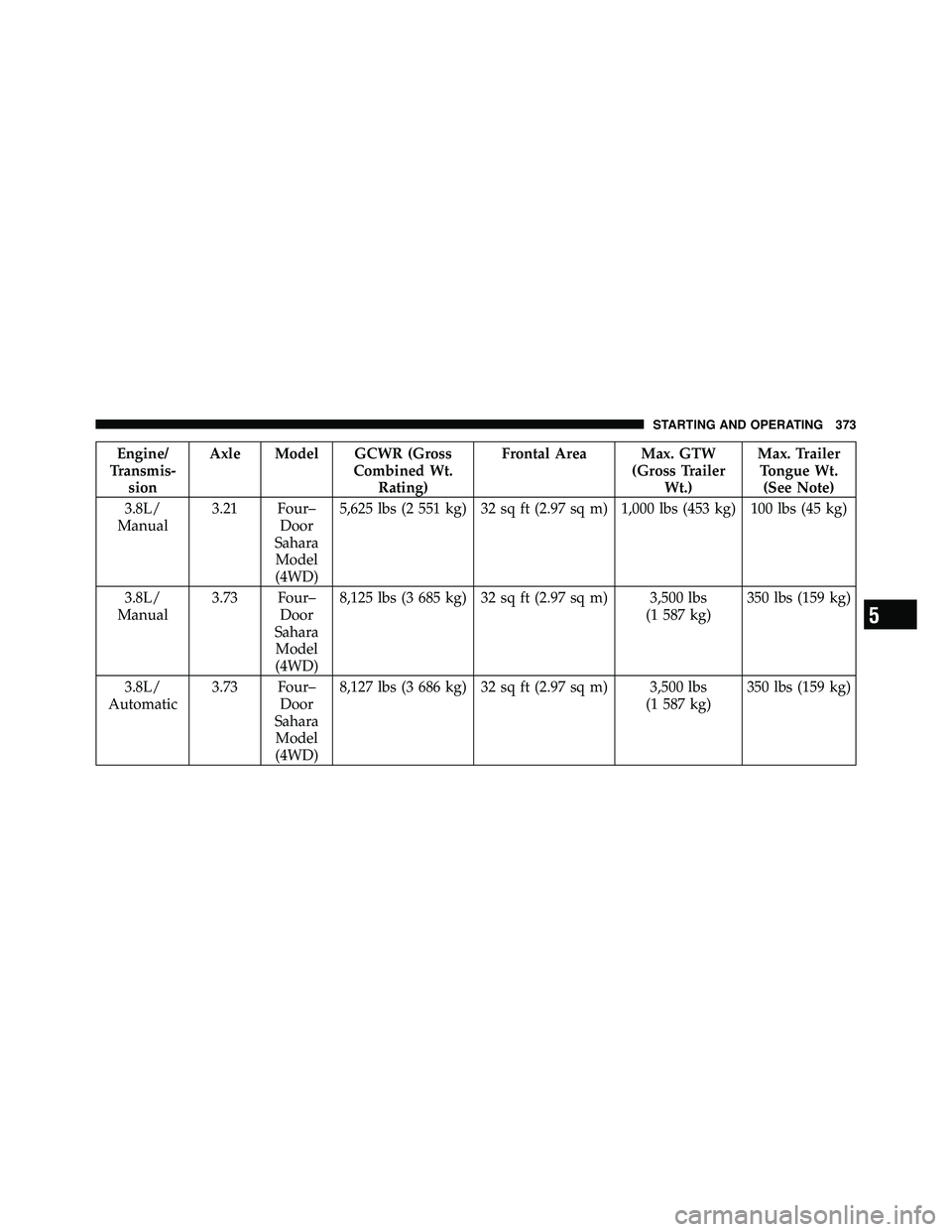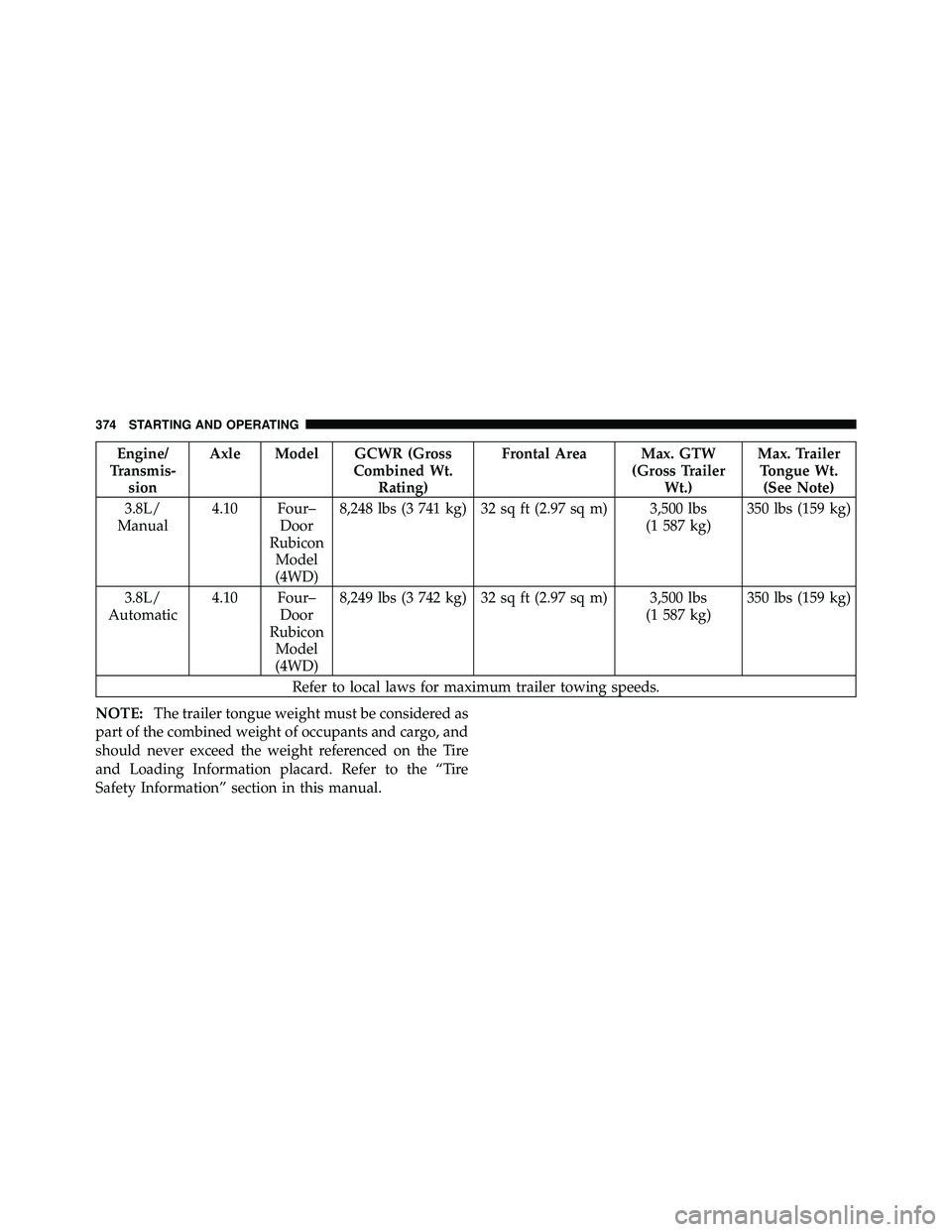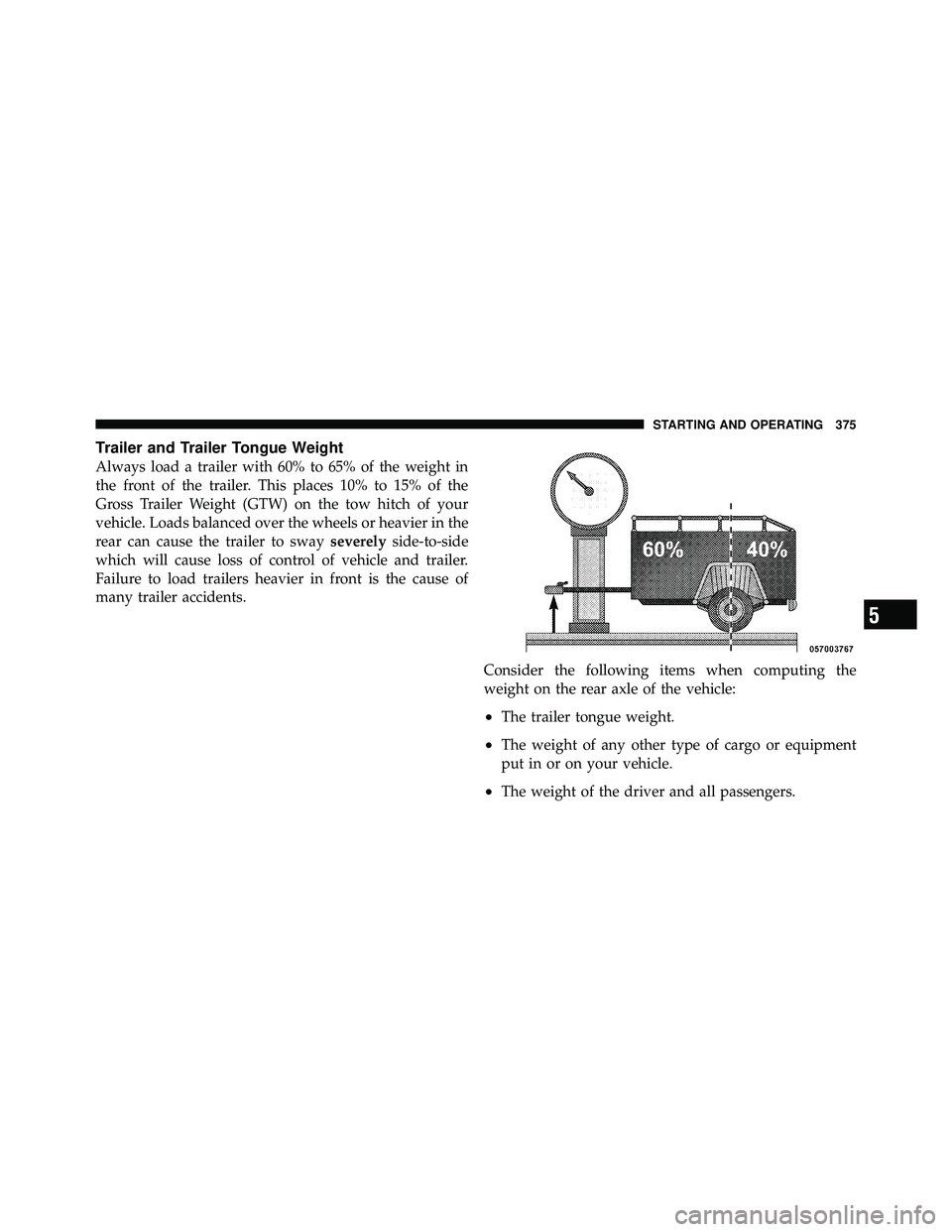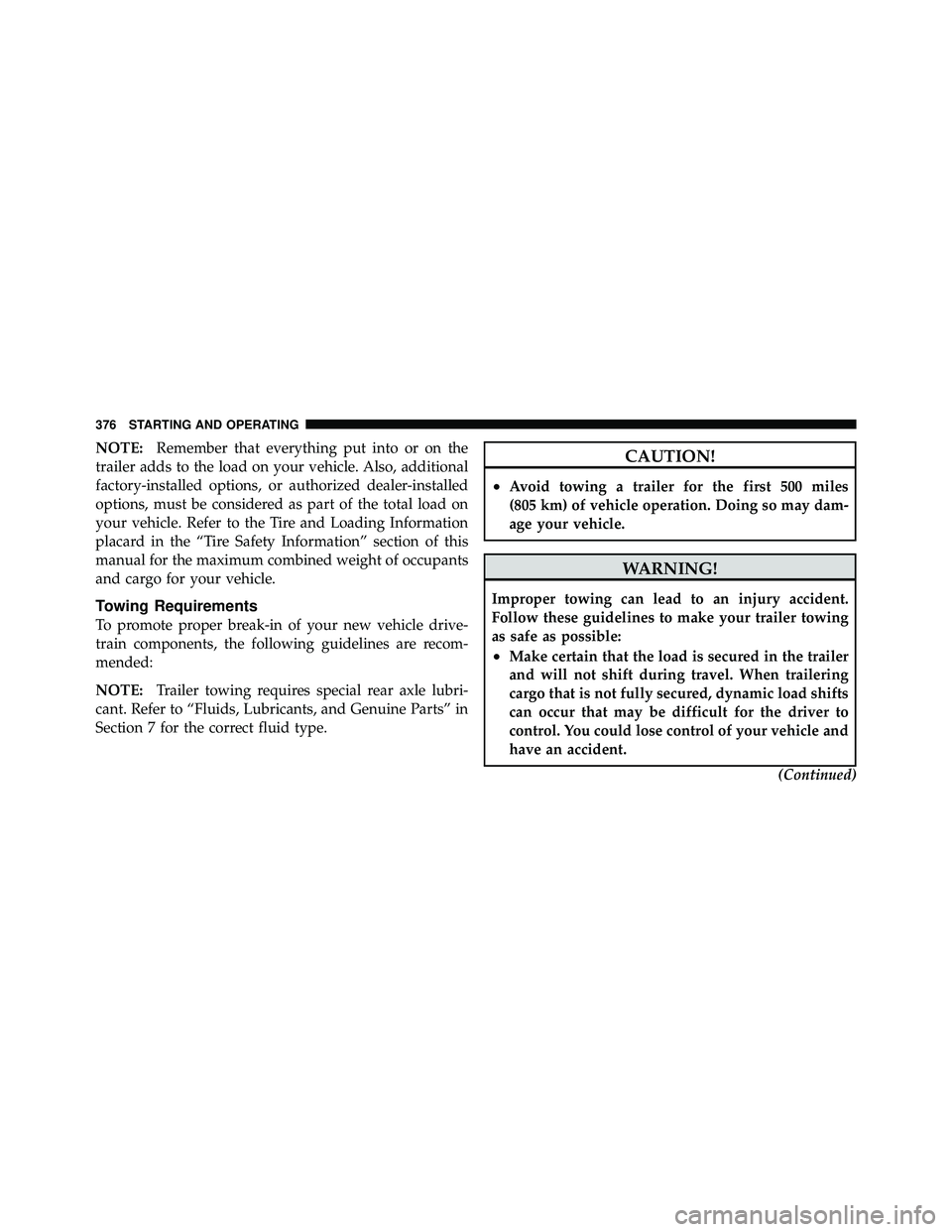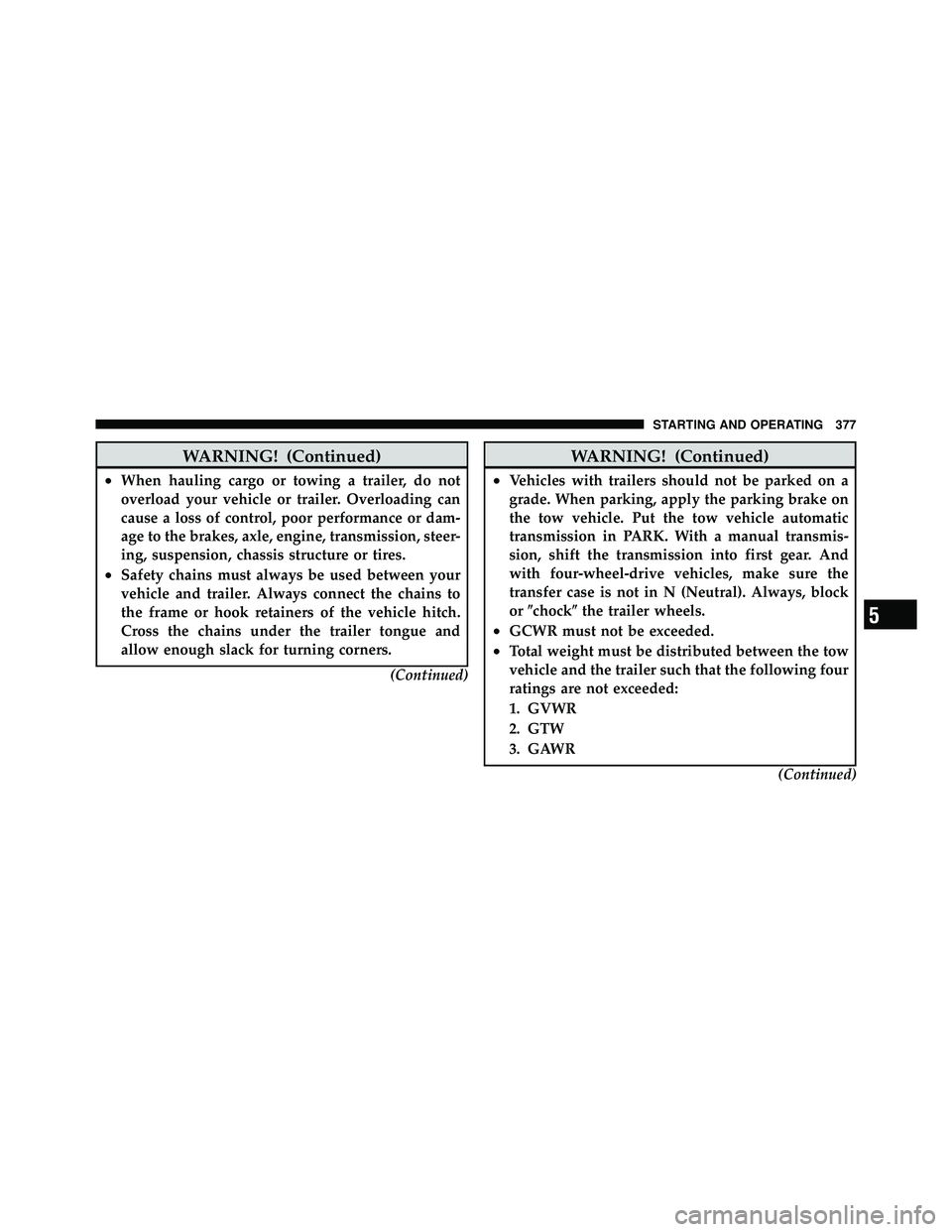JEEP WRANGLER 2009 Owners Manual
WRANGLER 2009
JEEP
JEEP
https://www.carmanualsonline.info/img/16/56060/w960_56060-0.png
JEEP WRANGLER 2009 Owners Manual
Trending: oil capacities, cooling, navigation system, height adjustment, fuse, parking brake, oil pressure
Page 371 of 502
Page 372 of 502
Engine/
Transmis- sion Axle Model GCWR (Gross
Combined Wt.Rating) Frontal Area Max. GTW
(Gross TrailerWt.) Max. Trailer
Tongue Wt. (See Note)
3.8L/
Manual 3.21 Two–
Door
Sahara Model
(4WD) 5,231 lbs (2 373 kg) 25 sq ft (2.32 sq m) 1,000 lbs (453 kg) 100 lbs (45 kg)
3.8L/
Manual 3.73 Two–
Door
Sahara Model
(4WD) 6,231 lbs (2 826 kg) 25 sq ft (2.32 sq m) 2,000 lbs (907 kg) 200 lbs (91 kg)
3.8L/
Automatic 3.73 Two–
Door
Sahara Model
(4WD) 6,233 lbs (2 827 kg) 25 sq ft (2.32 sq m) 2,000 lbs (907 kg) 200 lbs (91 kg)
370 STARTING AND OPERATING
Page 373 of 502
Page 374 of 502
Engine/
Transmis- sion Axle Model GCWR (Gross
Combined Wt.Rating) Frontal Area Max. GTW
(Gross TrailerWt.) Max. Trailer
Tongue Wt. (See Note)
3.8L/
Automatic 3.73 Four–
Door
Sahara Model
(2WD) 7,893 lbs (3 580 kg) 32 sq ft (2.97 sq m) 3,500 lbs
(1 587 kg)350 lbs (159 kg)
3.8L/
Manual 3.21 Four–
Door XModel
(4WD) 5,431 lbs (2 463 kg) 32 sq ft (2.97 sq m) 1,000 lbs (453 kg) 100 lbs (45 kg)
3.8L/
Manual 3.73 Four–
Door XModel
(4WD) 7,931 lbs (3 597 kg) 32 sq ft (2.97 sq m) 3,500 lbs
(1 587 kg)350 lbs (159 kg)
3.8L/
Automatic 3.73 Four–
Door XModel
(4WD) 7,932 lbs (3 598 kg) 32 sq ft (2.97 sq m) 3,500 lbs
(1 587 kg)350 lbs (159 kg)
372 STARTING AND OPERATING
Page 375 of 502
Page 376 of 502
Engine/
Transmis- sion Axle Model GCWR (Gross
Combined Wt.Rating) Frontal Area Max. GTW
(Gross TrailerWt.) Max. Trailer
Tongue Wt. (See Note)
3.8L/
Manual 4.10 Four–
Door
Rubicon Model
(4WD) 8,248 lbs (3 741 kg) 32 sq ft (2.97 sq m) 3,500 lbs
(1 587 kg)350 lbs (159 kg)
3.8L/
Automatic 4.10 Four–
Door
Rubicon Model
(4WD) 8,249 lbs (3 742 kg) 32 sq ft (2.97 sq m) 3,500 lbs
(1 587 kg)350 lbs (159 kg)
Refer to local laws for maximum trailer towing speeds.
NOTE: The trailer tongue weight must be considered as
part of the combined weight of occupants and cargo, and
should never exceed the weight referenced on the Tire
and Loading Information placard. Refer to the “Tire
Safety Information” section in this manual.
374 STARTING AND OPERATING
Page 377 of 502
5
STARTING AND OPERATING 375
Page 378 of 502
NOTE:Remember that everything put into or on the
trailer adds to the load on your vehicle. Also, additional
factory-installed options, or authorized dealer-installed
options, must be considered as part of the total load on
your vehicle. Refer to the Tire and Loading Information
placard in the “Tire Safety Information” section of this
manual for the maximum combined weight of occupants
and cargo for your vehicle.
Towing Requirements
To promote proper break-in of your new vehicle drive-
train components, the following guidelines are recom-
mended:
NOTE: Trailer towing requires special rear axle lubri-
cant. Refer to “Fluids, Lubricants, and Genuine Parts” in
Section 7 for the correct fluid type.
Page 379 of 502
Page 380 of 502
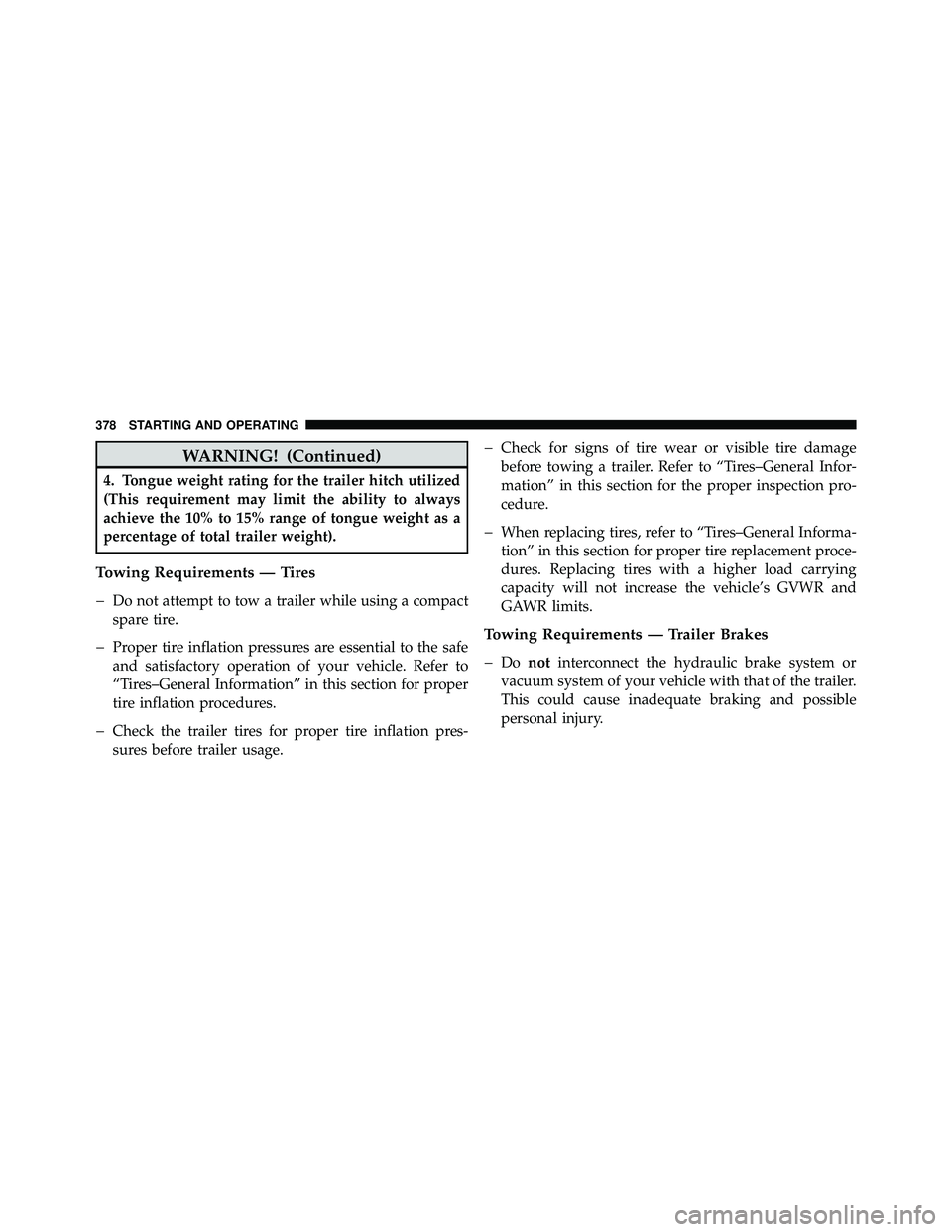
WARNING! (Continued)
4. Tongue weight rating for the trailer hitch utilized
(This requirement may limit the ability to always
achieve the 10% to 15% range of tongue weight as a
percentage of total trailer weight).
Towing Requirements — Tires
�
Do not attempt to tow a trailer while using a compact
spare tire.
�Proper tire inflation pressures are essential to the safe
and satisfactory operation of your vehicle. Refer to
“Tires–General Information” in this section for proper
tire inflation procedures.
�Check the trailer tires for proper tire inflation pres-
sures before trailer usage.
�Check for signs of tire wear or visible tire damage
before towing a trailer. Refer to “Tires–General Infor-
mation” in this section for the proper inspection pro-
cedure.
�When replacing tires, refer to “Tires–General Informa-
tion” in this section for proper tire replacement proce-
dures. Replacing tires with a higher load carrying
capacity will not increase the vehicle’s GVWR and
GAWR limits.
Towing Requirements — Trailer Brakes
�
Do not interconnect the hydraulic brake system or
vacuum system of your vehicle with that of the trailer.
This could cause inadequate braking and possible
personal injury.
378 STARTING AND OPERATING
Trending: fog light, roof rack, change language, snow chains, service reset, traction control, overheating
